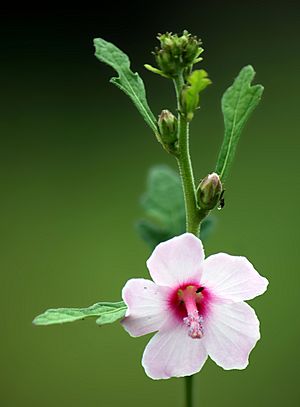Caesarweed facts for kids
Quick facts for kids Caesarweed |
|
|---|---|
 |
|
| Scientific classification | |
| Genus: |
Urena
|
| Species: |
lobata
|
| Synonyms | |
|
|
Urena lobata, often called Caesarweed or Congo jute, is a plant that grows like a small bush. It can be anywhere from about 1.5 feet (0.5 meters) to 8 feet (2.5 meters) tall. Its stems are covered with tiny, star-shaped hairs and sometimes have a purple color.
Caesarweed is considered a weed because it grows easily where it's not wanted. You can find it all over warm, tropical parts of the world, including places like Brazil and Southeast Asia.
Contents
What Does Caesarweed Look Like?
Each Caesarweed plant usually starts as a single stem. From this main stem, it sends out many bushy branches. The leaves are shaped like an open hand with "fingers" or lobes spreading out. Just like the stems, the leaves also have tiny hairs on them.
The flowers of the Caesarweed plant are a pretty pink-violet color. They are about one centimeter wide. The fruit of the plant is also hairy. These tiny hairs help the fruit stick to clothing or animal fur, which helps the plant spread its seeds around.
Why Is Caesarweed a Problem?
Caesarweed is known for being an invasive species. This means it can spread quickly and take over areas where it doesn't belong. It often grows in places that have been disturbed, like eroded land, farm fields, and pastures where animals graze.
In Florida, United States, Caesarweed is a big problem. It usually grows there for one year (as an annual plant). But in the southern parts of Florida, it can live for many years (perennially). In Florida, this plant can grow very fast. It can reach heights of 1.5 feet (0.5 meters) to 6.5 feet (2 meters) in its first year!
However, Caesarweed doesn't grow well if there are tall grasses around it. It also struggles to grow under the shade of other plants or trees.
How to Manage Caesarweed
To control Caesarweed, experts at the University of Florida suggest a few methods:
- Prevention: It's best to stop the plant before it makes seeds. Also, try to avoid driving vehicles through areas where Caesarweed grows. This helps prevent spreading its seeds.
- Mulching and Shading: Putting down mulch or creating shade can stop new Caesarweed seeds from sprouting.
- Chemicals: Sometimes, special plant-killing chemicals called herbicides are used to get rid of Caesarweed.
Images for kids
-
Page 693 of the Encyclopédie
(3rd edition, volume 1)
See also
 In Spanish: Urena lobata para niños
In Spanish: Urena lobata para niños
- Urena lobata in West African plants – A Photo Guide.


